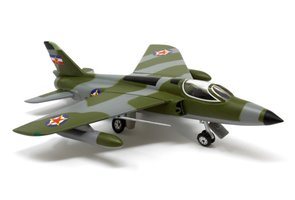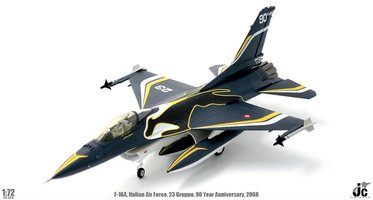P40E Tomahawk 77 Sqn RAAF 1942
| Model manufacturer: | Easy Model |
| Order code: | EM37271 |
| Scale: | 1:72 |
| Material: | Plastic |
| EAN: | 9580208372716 |
| Weight: | 0.4 kg |
| Dimensions: | 13.2×15.5×6.2 cm (L×W×H) |
| Air company: | RAAF |
| Aircraft manufacturer: | Curtiss-Wright Corporation |
Product description
The Curtiss P-40 Warhawk was an American single-engined, single-seat, all-metal fighter and ground-attack aircraft that first flew in 1938. The P-40 design was a modification of the previous Curtiss P-36 Hawk which reduced development time and enabled a rapid entry into production and operational service. The Warhawk was used by most Allied powers during World War II, and remained in frontline service until the end of the war. It was the third most-produced American fighter, after the P-51 and P-47; by November 1944, when production of the P-40 ceased, 13,738 had been built, all at Curtiss-Wright Corporation's main production facilities at Buffalo, New York.
Warhawk was the name the United States Army Air Corps adopted for all models, making it the official name in the United States for all P-40s. TheBritish Commonwealth and Soviet air forces used the name Tomahawk for models equivalent to the P-40B and P-40C, and the name Kittyhawk for models equivalent to the P-40D and all later variants.
P-40s first saw combat with the British Commonwealth squadrons of theDesert Air Force in the Middle East and North African campaigns, during June 1941. No. 112 Squadron Royal Air Force, was among the first to operate Tomahawks in North Africa and the unit was the first Allied military aviation unit to feature the "shark mouth" logo, copying similar markings on some Luftwaffe Messerschmitt Bf 110 twin-engine fighters.
The P-40's lack of a two-stage supercharger made it inferior to Luftwaffe fighters such as the Messerschmitt Bf 109 or the Focke-Wulf Fw 190 in high-altitude combat and it was rarely used in operations in Northwest Europe. Between 1941 and 1944, the P-40 played a critical role with Allied air forces in three major theaters: North Africa, the Southwest Pacific and China. It also had a significant role in the Middle East, Southeast Asia, Eastern Europe, Alaskaand Italy. The P-40's performance at high altitudes was not as important in those theaters, where it served as an air superiority fighter, bomber escort andfighter bomber. Although it gained a postwar reputation as a mediocre design, suitable only for close air support, recent research including scrutiny of the records of individual Allied squadrons, indicates that the P-40 performed surprisingly well as an air superiority fighter, at times suffering severe losses but also taking a very heavy toll of enemy aircraft, especially when flown against the lightweight and maneuverable Japanese fighters like the Oscar andZero in the manner recommended in 1941 by General Claire Chennault, the AVG's commander in southern China. The P-40 offered the additional advantage of low cost, which kept it in production as a ground-attack aircraft long after it was obsolete as a fighter. In 2008, 29 P-40s were airworthy.The P-40 was semi-agile at medium to low altitude, as it was originally conceived as though at lower speeds it could definitely not out-turn the extremely maneuverableJapanese fighters such as the A6M Zero and Nakajima Ki-43 "Oscar".
Allison V-1710 engines produced about 1,040 hp (780 kW) at sea level and at 14,000 ft (4,300 m): not powerful by the standards of the time and the early P-40 variants' top speeds were unimpressive. Also, the single-stage, single-speed supercharger meant that the P-40 could not compete with contemporary designs as a high-altitude fighter. Later versions, with 1,200 hp (890 kW) Allisons or more powerful 1,400 hp Packard Merlin engines were more capable. Climb performance was fair to poor, depending on the subtype. Dive acceleration was good and dive speed was excellent. The highest-scoring P-40 ace, Clive Caldwell(RAAF), who claimed 22 of his 28½ kills in the type, said that the P-40 had "almost no vices", although "it was a little difficult to control in terminal velocity". Caldwell added that the P-40 was "faster downhill than almost any other aeroplane with a propeller."
The P-40 tolerated harsh conditions in the widest possible variety of climates. It was a semi-modular design and thus easy to maintain in the field. It lacked innovations of the time, such as boosted ailerons or automatic leading edge slats, but it had a strong structure including a five-spar wing, which enabled P-40s to survive some midair collisions: both accidental impacts and intentional ramming attacks against enemy aircraft were occasionally recorded as victories by the Desert Air Force and Soviet Air Forces. Caldwell said P-40s "would take a tremendous amount of punishment, violent aerobatics as well as enemy action." Operational range was good by early war standards, and was almost double that of the Supermarine Spitfire or Messerschmitt Bf 109, although it was inferior to theMitsubishi A6M Zero, Nakajima Ki-43 and Lockheed P-38 Lightning.















